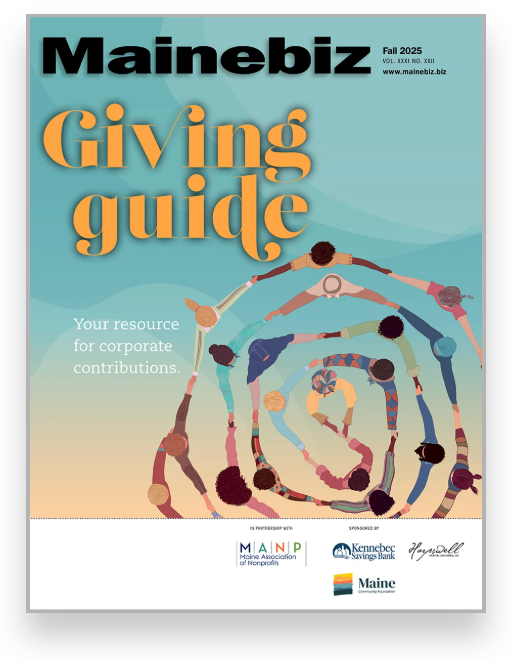Processing Your Payment
Please do not leave this page until complete. This can take a few moments.
- News
-
Editions
View Digital Editions
Biweekly Issues
- October 20, 2025
- October 6, 2025
- September 22, 2025
- September 8, 2025
- August 25, 2025
- August 11, 2025
- + More
Special Editions
- Lists
- Viewpoints
- Our Events
- Calendar
- Biz Marketplace
Crowd control | Heather McCarthy, executive director of the American Folk Festival on the Bangor Waterfront, on the festival's first year on its own
We had somewhere in the vicinity of 145,000 people this year. We didn't know what to expect for attendance; we're pleasantly surprised not only with the attendance, which tops last year's, but, in addition, that those folks who came almost unanimously reported great satisfaction with the event. Certainly from a logistics front we handled those crowds very smoothly and very safely.
Getting that many people safely into downtown Bangor, getting them parked and getting folks onto the festival site requires a huge amount of collaboration with the police department, public works and the shuttle bus system. Once they're on site you need to make sure you've got room for them at the various venues. We have five performance stages, but that's still an awful lot of people milling around from one end of the festival site to the other and looking for directions or services, as well as the occasional skinned knee or lost person. It's really a logistical and safety issue.
I would say the total attendance was larger than our hopes for a crowd, but we had the infrastructure in place to handle them if they showed up. That's entirely due to the fact that we had three years' experience with the National, so the systems that we put in place were capable of handling that larger crowd. We weren't terribly surprised at that number, based on how the attendance at the three-year national [festival] increased from year to year.
If we'd had that many in year one, we would have been knee deep in people, not being able to get from one end [of the festival] to the other, but we've learned a lot over the last four years. We weren't prepared for the crowd that showed up in 2002, and we didn't have enough porta-potties, and we didn't have enough food vendors, and we didn't have a traffic flow that worked efficiently. Since that time, however, I don't think that complaints about those public services have been part of the reaction. We continued to learn a little more each year about crowd preferences and crowd movements.
Audience as marketing tool
As the festival has developed over the past four years in Bangor, the city has also been working on redeveloping the waterfront. Every year there have been slight changes that the city has made to the site that we really take advantage of. They have dramatically improved the landscaping and the lighting and the walkways in and around the waterfront, which has improved the crowd experience each year. In the process of making a lot of these landscaping changes, they've installed a lot of electrical outlets and water outlets; some of that infrastructure is needed to make food vendors, craft vendors and our stages run that much more efficiently, so that's helped as well.
I don't think that we've changed anything ˆ I think that we've intentionally kept everything the same. And the reason that we're continuing to have increased success is that our audience keeps coming back and keeps telling people, and with each successive year they get an additional dose of confidence in the event that we're going to present to them. So those things are all just adding up on top of each other. We're developing a very loyal audience who, in themselves, are probably our best marketing tool.
It would be fair to describe the festival as the traditional music of the cultures that are a part of America today. And that's everything from cultures that have been part of America forever, like different native traditions, to music from some of the more recent immigrant cultures, with Somali or Thai or other more recent immigrants. But as long as the music is traditionally part of your community, that's the stamp of authenticity that we're going for. It's not singer/songwriters.
We had some of the bigger names ˆ we had Del McCoury, a bluegrass artist; our Irish band, a group called Danú, was really popular. For the first time this year, we had ska music, which drew a big crowd. Then we had the things that weren't necessarily the big draws, but people were really excited [about] when they heard them ˆ the genre of music called Hawaiian slack key guitar, Puerto Rican salsa and Québécois music. Just a lot of different things.
We get a great deal of production programming and technical support [from NCTA], but all the money ˆ even when it was the National Folk Festival ˆ was raised locally. The NCTA shows you what it's supposed to look like, they walk you through the different components and help you identify local resources. If you've got to bring in resources from outside the state, they'll help you access those as well. One of the things they're trying to do all this time is set you up to be able to continue on your own.
We've had a great working relationship with them and we actually have continued that relationship. Despite the fact that we're not the National Folk Festival anymore, we are continuing to work with the NCTA for some of the services that they have provided in producing the National.
Dollars and cents
Fortunately, autumn is our downtime. It's a little more calm, but there's still things to do. Through September and October we spend our time processing the prior year's event, getting all our books in order, calculating surveys, figuring out who came and what they thought of the event.
Come November we've already started having programming meetings to consider which performers to have for the upcoming year. By December we're recruiting food vendors and craft vendors and setting up the review process for those systems. During the first quarter of the year we're really getting a lot of our technical folks on board as far as sound systems and staging. We start our marketing efforts in January or February on a regional basis, and then at about April on a local basis.
Our full staff is a staff of three, but then we've got a board of directors of fifteen and we've [got] several different [volunteer] committees that meet periodically which are probably another 75 people.
We start recruiting volunteers as early as January, and by July we've got something like 750 volunteers on board and ready to go. This year we had probably 825 volunteers doing all sorts of things, from parking cars to selling T-shirts to giving out schedules. There's obviously no way that you could build a staff that could do all that. Their rewards are our undying gratitude, a free T-shirt and an invitation to the Saturday night party. We have a lot of repeat volunteers. They are very dedicated to seeing the event succeed, and that's one of the reasons it has succeeded, because so many people want to make sure it happens.
Our board of directors is very much involved in making sure that we recruit the people we need to recruit and we raise the money that we need to raise and all those different policy decisions that need to be made, so they're a big help as well.
The day-to-day activities really happen out of this office. Fundraising is year round. Combined cash and in-kind [support], it's approximately a $1-million-a-year event. We're a not-for-profit. It looks like this year is the first year that we're going to [break even].
There are essentially five sources for our funds: government funding (from city, state and federal sources), grants, individual gifts, earned income and corporate gifts. Earned income ˆ from T-shirt sales, booth rental fees, beer vendors, parking fees and a bucket brigade for donations ˆ and corporate gifts are the largest percentage of our revenue. Local members of the business community see what this event is doing for the region and want to contribute in order to help it happen. We also have corporations that are based outside of the Bangor region who look at the festival as a good marketing opportunity.
Our greatest expense is artists' fees and artists' travel. With fees, travel, housing and food, it costs us about $220,000 to bring those different folks into town and take care of them while they're here. On the operation side, tents, portable toilets, radios, golf carts and shuttle buses are all significant expenses to the festival.
We're estimating, based on a study that Eastern Maine Development Corp. did for us, that the festival is bringing an economic impact to the region of about $5 million a year. Some of the other impacts like community pride and cultural exposure and artistic things like that are a little trickier to calculate, but economic impact is one that is easy to get a grip on.
Mainebiz web partners

The Giving Guide
The Giving Guide helps nonprofits have the opportunity to showcase and differentiate their organizations so that businesses better understand how they can contribute to a nonprofit’s mission and work.
Learn More
Work for ME
Work for ME is a workforce development tool to help Maine’s employers target Maine’s emerging workforce. Work for ME highlights each industry, its impact on Maine’s economy, the jobs available to entry-level workers, the training and education needed to get a career started.
Learn More
Groundbreaking Maine
Whether you’re a developer, financer, architect, or industry enthusiast, Groundbreaking Maine is crafted to be your go-to source for valuable insights in Maine’s real estate and construction community.
Learn more-
The Giving Guide
The Giving Guide helps nonprofits have the opportunity to showcase and differentiate their organizations so that businesses better understand how they can contribute to a nonprofit’s mission and work.
-
Work for ME
Work for ME is a workforce development tool to help Maine’s employers target Maine’s emerging workforce. Work for ME highlights each industry, its impact on Maine’s economy, the jobs available to entry-level workers, the training and education needed to get a career started.
-
Groundbreaking Maine
Whether you’re a developer, financer, architect, or industry enthusiast, Groundbreaking Maine is crafted to be your go-to source for valuable insights in Maine’s real estate and construction community.
ABOUT
NEW ENGLAND BUSINESS MEDIA SITES
No articles left
Get access now
In order to use this feature, we need some information from you. You can also login or register for a free account.
By clicking submit you are agreeing to our cookie usage and Privacy Policy
Already have an account? Login
Already have an account? Login
Want to create an account? Register
Get access now
In order to use this feature, we need some information from you. You can also login or register for a free account.
By clicking submit you are agreeing to our cookie usage and Privacy Policy
Already have an account? Login
Already have an account? Login
Want to create an account? Register







Comments